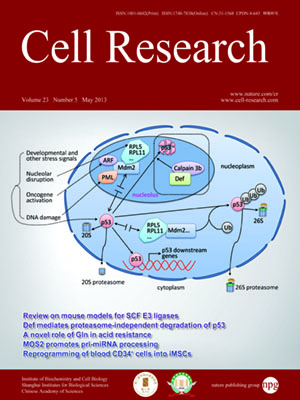
Volume 23, No 5, May 2013
ISSN: 1001-0602
EISSN: 1748-7838 2018
impact factor 17.848*
(Clarivate Analytics, 2019)
Volume 23 Issue 5, May 2013: 599-619
REVIEWS
Genetically engineered mouse models for functional studies of SKP1-CUL1-F-box-protein (SCF) E3 ubiquitin ligases
Weihua Zhou1,2, Wenyi Wei3 and Yi Sun1
1Division of Radiation and Cancer Biology, Department of Radiation Oncology, University of Michigan, 4424B Medical Science-I, 1301 Catherine Street, Ann Arbor, MI 48109, USA
2Department of Oncology, the Second Affiliated Hospital of Nanchang University, 1 Minde Road, Nanchang, Jiangxi 330006, China
3Department of Pathology, Beth Israel Deaconess Medical Center, Harvard Medical School, Boston, MA 02215, USA
Correspondence: Yi Sun(sunyi@umich.edu)
The SCF (SKP1 (S-phase-kinase-associated protein 1), Cullin-1, F-box protein) E3 ubiquitin ligases, the founding member of Cullin-RING ligases (CRLs), are the largest family of E3 ubiquitin ligases in mammals. Each individual SCF E3 ligase consists of one adaptor protein SKP1, one scaffold protein cullin-1 (the first family member of the eight cullins), one F-box protein out of 69 family members, and one out of two RING (Really Interesting New Gene) family proteins RBX1/ROC1 or RBX2/ROC2/SAG/RNF7. Various combinations of these four components construct a large number of SCF E3s that promote the degradation of many key regulatory proteins in cell-context, temporally, and spatially dependent manners, thus controlling precisely numerous important cellular processes, including cell cycle progression, apoptosis, gene transcription, signal transduction, DNA replication, maintenance of genome integrity, and tumorigenesis. To understand how the SCF E3 ligases regulate these cellular processes and embryonic development under in vivo physiological conditions, a number of mouse models with transgenic (Tg) expression or targeted deletion of components of SCF have been established and characterized. In this review, we will provide a brief introduction to the ubiquitin-proteasome system (UPS) and the SCF E3 ubiquitin ligases, followed by a comprehensive overview on the existing Tg and knockout (KO) mouse models of the SCF E3s, and discuss the role of each component in mouse embryogenesis, cell proliferation, apoptosis, carcinogenesis, as well as other pathogenic processes associated with human diseases. We will end with a brief discussion on the future directions of this research area and the potential applications of the knowledge gained to more effective therapeutic interventions of human diseases.
Cell Research (2013) 23:599–619. doi:10.1038/cr.2013.44; published online 26 March 2013
FULL TEXT | PDF
Browse 2156


